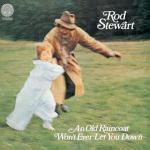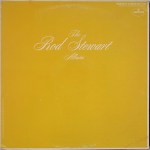 Skeptical Thinking Is Critical to Achieving Better Sound
Skeptical Thinking Is Critical to Achieving Better Sound
Record Collecting for Audiophiles from A to Z
Recently a fellow named Jared tried to correct our assertion that Rod Stewart’s early albums from the US are made from dubbed tapes, as is our contention.
Here is his letter:
Hey there. Just wanted to point out some errors on your listing for Rod Stewart’s “An Old Raincoat…” LP. The UK pressings are the ones made from dupes.
The first generation masters for all of Rod’s Mercury albums are in the US. All vinyl vintage pressings, UK or US, are made from EQ dupes.
The original US Polygram CDs mastered by Dennis Drake are straight off the original masters.
Thanks!
Naturally this information took us by surprise. We replied:
Jared,
Can you refer me to the source of your information?
Thanks,
TP
There was no answer to my query. Nor was I able to find any source for this information.
 I hadn’t played a domestic copy of The Rod Stewart album, the title Old Raincoat was released under in the states, in at least twenty years, probably more like thirty. It had sure sounded dubby to me back then. I stopped buying them a long time ago.
I hadn’t played a domestic copy of The Rod Stewart album, the title Old Raincoat was released under in the states, in at least twenty years, probably more like thirty. It had sure sounded dubby to me back then. I stopped buying them a long time ago.
Was I remembering the sound right? The odds were very high that I was, but I had to know for sure, even though I had no idea who Jared was or where his information came from.
I asked my main man Fred to get one in and give it a listen. Here is his report:
We played The Rod Stewart Album (domestic Old Raincoat) we got in and it sounds absolutely terrible. Super spitty and bright.
Are they all this bad? Who can say?
Could my UK pressing be made from copy tapes?
I suppose it’s possible. It doesn’t sound dubby to me, but it is not an especially good sounding record, unlike Rod’s third album, which is about as good sounding a rock record as is possible to make. (In the case of Every Picture, it’s the imports that are made from dubs. Go figure.)
Maybe Dennis Drake actually did get hold of the real master tapes when making his CD. He is a very talented engineer; I have many compact discs mastered by him and I don’t know of any that aren’t at least good sounding. For those of you who play CDs, you are free to give his version of An Old Raincost a try. Please let me know what you hear.
What’s that Smell?
But the reason Jared letter is being published is that it reeks of information that has not been verified by anyone’s ears. Certainly not Jared’s.
If, like Jared, you read something that sounds plausible, that you think might be true, why would you be so willing to believe it without any real evidence to back it up?
Even worse, the comments Jared makes weren’t even prefaced with “I’ve read that…” or “People seem to agree that…” No, Jared leaves no room for doubt. The information is presented as true.
Can anyone who has played both versions of Old Raincoat not hear how much better the UK pressing is?
We couldn’t. Nothing could have been more obvious to us than that one version is made from good tapes and one version is made from bad tapes.
What Business We Are Not In
We don’t put much stock into what people say about records for precisely this reason. We are in the business of testing them, not reading about them, and we are certainly not in the business of passing on unsubstantiated rumors spread by people we have never heard of.
If you want to find out whether something about records is true or not, then by all means, find out.
Don’t guess and don’t assume. Get the evidence.
And if you want to make the case for some domestic pressing you played being superior to our UK originals, we have a few tips on offer that will go a long way in helping you to be taken seriously by skeptics such as us.
There are many commentaries on this blog that can help anyone to improve the way he thinks about records.
I implore Jared and anyone else who might be interested to make use of them.
Further Reading
I am not sure one can really tell the difference between one generation if the tapes were properly transferred. I often cannot tell the difference when I copy my session masters. There will be a 3dB increase in noise in non-Dolby recordings, but from a low generation master, this will not be noticeable. The effects introduced during the mastering/cutting/plating/stamping process will likely be far greater. In any case, all commercial LP releases in the “old days” would have been from third or fourth generation masters. Classical labels such as RCA, Mercury, Decca and EMI mixed their classical recordings in real time to stereo, or right after recording onto 3 track tape. For non-classical, there might be track bouncing, overdubs etc, and so the tapes could easily have been copied multiple times before being assembled into the final stereo mix. Editing would be done on this tape, and then copied to produce production and safety masters. These will be further copied to make distribution masters to be sent to mastering facilities for cutting lacquer. Some labels required the cutting engineer to make another safety master before cutting the lacquer, in case something goes wrong and they can then use the safety master as backup. I know of no cases where lacquers were cut directly from the first generation master (the edited work part or the first copy off the work part), at least for major releases from the big labels. Most distribution masters I have come across are not Eq’d for vinyl. Some cutting engineers make an Eq’d copy from the distribution master, but most of the time, the Eq was applied real time during the cutting process.